
2012-2013 Vendée Globe highlights
by Vendée Globe media 27 Feb 2013 06:07 GMT
27 February 2013
The seventh edition of the Vendée Globe was a record-studded race (Youngest winner, smallest gap between the first two skippers, two sailors under 80 days, smallest gap between the first and the last skipper) that kept sailing enthusiasts on the edge of their seats for 104 days. Here is a week-by-week summary of the 2012-2013 edition of the greatest of the nonstop, single-handed, round-the-world races without assistance.
Week 1
Saturday, November 10. More than 300,000 people were out early in the morning to give the twenty skippers a warm sendoff despite the rainy and cold weather. Just like in any of the previous editions, the channel moment was an emotional one for the sailors embodying the public's dreams of adventure. French actor François Cluzet gave the start signal at 1.02PM. Five overeager competitors (Gabart, De Pavant, Gutkowski, Le Cléac'h and Riou) crossed the start line early while Bertrand de Broc (Votre Nom autour du Monde avec EDM Projets), who had damaged his boat 25 minutes before the official start, was already back on the pontoons. He eventually left thirteen hours after the others and sailed across poor Marc Guillemot (Safran) who lost his keel after only 4h43 in the race. The Breton skipper was the first to pull out of the race. Young and spirited François Gabart (Macif) immediately took the lead of the fleet and sailed aggressively in a rough sea. Then, after three days of race, came the second abandon. Kito de Pavant (Groupe Bel) hit a fishing boat, ripping off his boomsprit and roof, while he was in the cabin for a ten-minute nap. The French sailor changed his route and sailed to Cascais, Portugal.
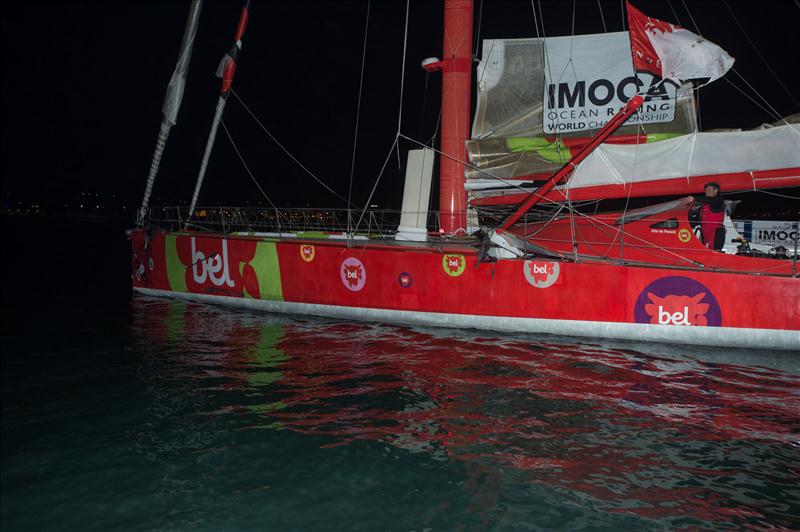
Damage from where a trawler struck Groupe Bel in the Vendée Globe - photo © Ricardo Pinto / Windreport / Groupe Bel
Meanwhile, behind Gabart, Le Cléac'h (Banque Populaire) and Stamm (Cheminées Poujoulat) kept up with the leader's intense rhythm, followed by Riou (PRB), who chose a more westerly route. This was the time for the very first tactical choices. That is when the youngest skipper in the fleet, Louis Burton, 27, also hit a fishing boat and decided to sail back to Les Sables d'Olonne to try to fix his damaged shroud. But Burton will eventually have to resign and pull out of the race. On the evening of Thursday, November 15, Samantha Davies (Savéol) dismasted in very rough weather conditions. She was the fourth sailor to pull out of the race and, after only one week, the Vendée Globe had already lost 20% of its fleet. Le Cléac'h became the new race leader off the Canary Islands, ahead of Gabart and Stamm. There are only 25 miles between the first three skippers and 100 miles between the first six.
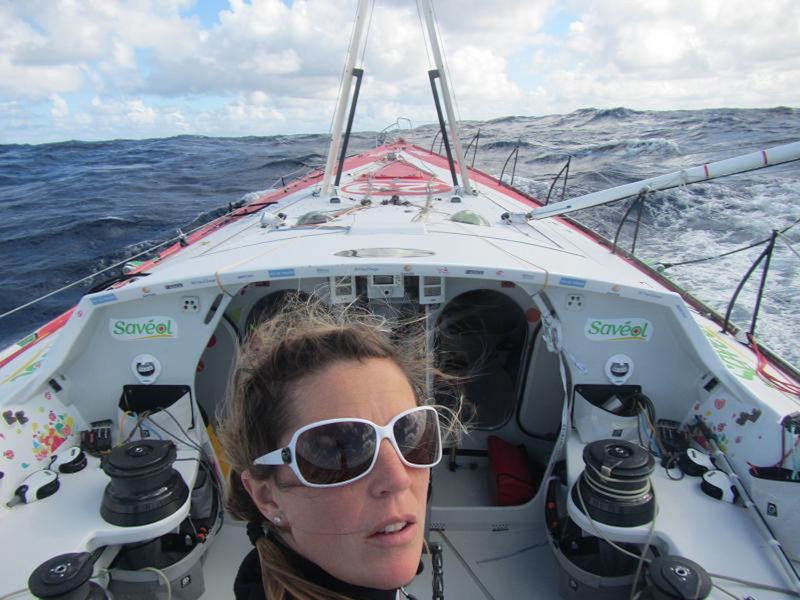
Sam Davies on the dismasted Saveol in the Vendée Globe 2012-2013 - photo © Sam Davies / Saveol
Week 2
The remaining skippers were back in much nicer sailing conditions when, on November 17, Jérémie Beyou (Maître CoQ) broke his keel jack while sailing northwest of Cape Verde and eventually pulled out of the race two days later. On the same weekend, Alex Thomson (Hugo Boss) broke his rudder tie bar but managed to repair it without losing ground. Meanwhile, Javier Sanso (ACCIONA 100%EcoPowered) had to climb up his mast to fix his main sail traveller. The fleet was made up of three separate groups: the favourites (Le Cléac'h, Gabart, Dick, Stamm, Riou, Thomson), the senior outsiders (Golding, Wavre, Le Cam), and the "latecomers" (Boissières, De Lamotte, De Broc, Di Benedetto, Gutek, Sanso). On day 9, Le Cléac'h entered the infamous Doldrums, which gave the chasing skippers an opportunity to come back. That area of extremely unstable winds proved to be particularly tough on the leaders and their race became so close some skippers could actually see each other for a few hours! On November 21, after days of surprising route choices, Poland's Zbigniew "Gutek" Gutkowski (Energa), abandons the race because of recurring autopilot issues. On the same day, Armel Le Cléac'h left the Doldrums behind and was the first skipper to cross the Equator. The chasing skippers followed him a few hours behind and closed the gap on him in the South Atlantic. Behind them, Mike Golding (Gamesa) crossed the Equator for the 22nd time and, after 12 days at sea, eight of the Vendée Globe skippers were in the south hemisphere, with Armel Le Cléac'h leading them for an entire week. Because of particularly southerly St Helena's Highs, the first skippers had to choose a westerly route.
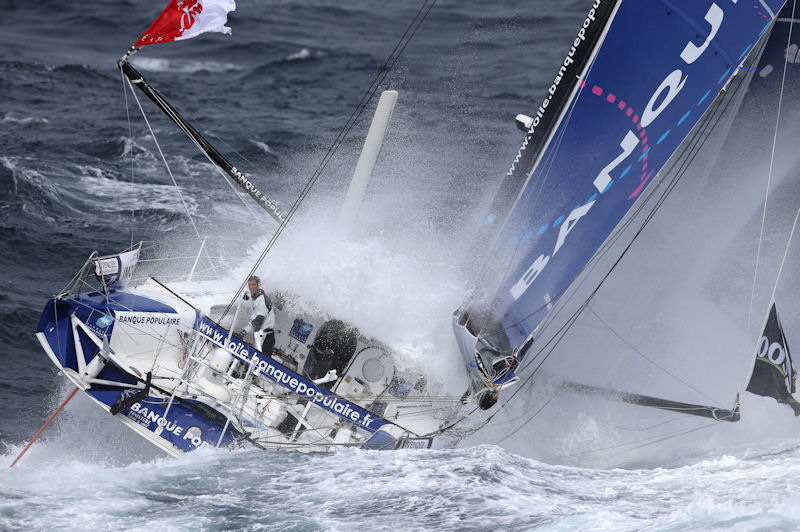
Armel Le Cleac'h on Banque Populaire takes the lead in the Vendée Globe 2012-2013 - photo © Jean Marie Liot / DPPI
Week 3
On Saturday, November 24, Vincent Riou hit an Unidentified Floating Object - a massive drifting buoy – tearing the front part of PRB's hull and seriously damaging the ourigger. After a first repair attempt, the former Vendée Globe winner eventually had to put an end to his race on the next day. Skippers' strategies were exposed as Jean-Pierre Dick (Virbac-Paprec 3) moved away from the direct route and sailed south, soon followed by François Gabart, while Armel Le Cléac'h continued on the initial route. Skippers at the back of the fleet, led by Jean Le Cam (SynerCiel) with Mike Golding and Dominique Wavre (Mirabaud), started closing the gap. 250 miles behind the Swiss, Javier Sanso found himself 150 miles ahead of Arnaud Boissières (AKENA Vérandas).
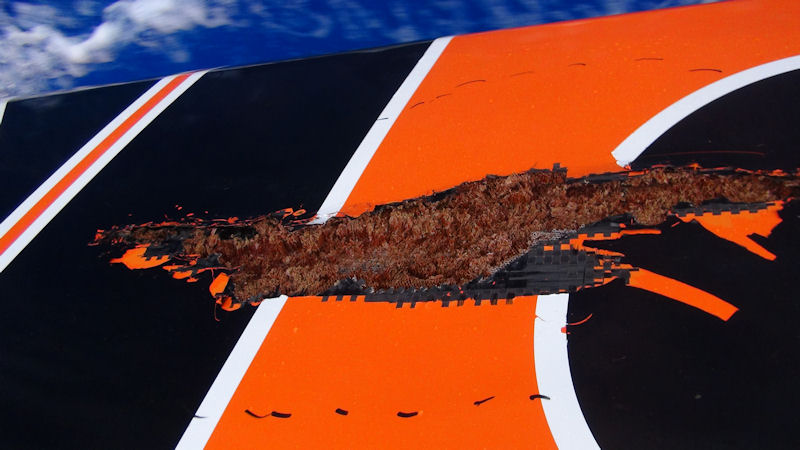
The damage to Vincent Riou's PRB after hitting a metalic harbour buoy floating in the middle of the ocean - photo © Vincent Riou / PRB
Week 4
The different options chosen by the skippers started showing results on November 30, when the leader himself admitted the southerly route may have been the best. Dick briefly took the lead of the race on December 1, just before entering the " Great South " from Armel Le Cléac'h, who had led since November 16. In the process, the Virbac-Paprec skipper set a new 24-hour record, covering more than 500 miles – 502! – in a day. But François Gabart was the one crossing the first of the eight ice gates first. The leaders - Le Cléac'h, Gabart, Dick and Stamm – regrouped with Thomson 100 miles behind them while the pendant que les " senior sailors " tried to keep up with the rhythm 400 miles behind the front runners. On December 2, Jean Le Cam noticed a net was caught up in his keel and decided to dive to release it. The complex operation was a success and became one of the unforgettable moments in the race. On Monday, December 3, Armel Le Cléac'h was the first to round the Cape of Good Hope after 22d23h46' of race, beating the previous record, set by Vincent Riou in 2004, by more than 24 hours. Finally, it was Indian Ocean time!
The leaders' speed in such strong wind widened the gap between the frontrunners and the chasing skippers, with 2,200 miles (4,000 kilometres) between the leaders and the last skipper. The former tried to sail as fast as they possibly can to avoid the anticyclone threatening to catch up with them, which turned out to be difficult because of a tricky cross sea. While Armel Le Cléac'h was heading north to cross the ice gates, his opponents chose a curvier southerly route, despite the risk of coming across ice. Behind them, the " senior sailors " were in a close fight - Dominique Wavre and Jean Le Cam even sailed at sight for a few hours on December 7. Armel Le Cléac'h might have been the first to cross the Crozet gate, the anticyclone ended up catching up with him and the Banque Populaire skipper gave up his leadership position to Gabart and then to Stamm, before taking it back a few days later while the other skippers were forced to head north to cross the mandatory gate.
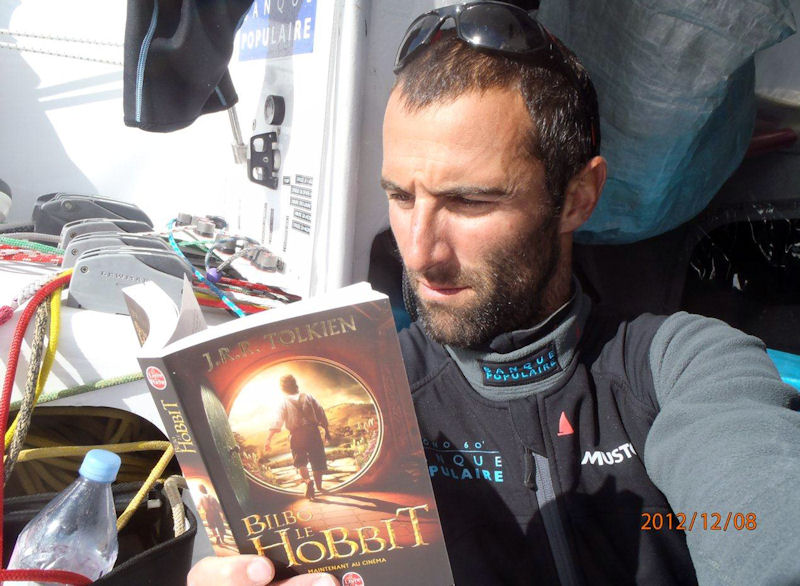
Armel Le Cleac'h reads 'The Hobbit' on Banque Populaire during the Vendée Globe 2012-2013 - photo © Armel Le Cleac'h / Banque Populaire
Week 5
Armel Le Cléac'h took the lead on December 8th. Once the second ice gate was passed, the weather conditions were suitable for speed records with a strong northwesterly wind that pushed leaders on a little formed sea. François Gabart was the fastest in that speed game and shattered the 24 hours record with 534.48 miles... Incredible! He took the opportunity to take over the lead, and two days later, he set a new record: the best time ever achieved between Les Sables d'Olonne and Cape Leeuwin (34d10h23'). The duel with Le Cléac'h looked like a match-race as the distance between the two leaders was reduced to its minimum compared the entire Vendée Globe journey... Therefore, it was increasingly difficult for their rivals to follow them, particularly for Bernard Stamm, who faced several problems with his mainsail boards, and a very unlucky Alex Thomson, who hit two UFOs in less than 24 hours, which destroyed his hydrogenerator, damaged his rudder and broke another rudder tie bar. Only Jean-Pierre Dick managed to stay in the leaders' wake. While crossing the Amsterdam gate, the MACIF skipper was only 20 minutes ahead, after 24,000km of sailing! At the end of the fifth week, Gabart, Le Cléac'h and Dick managed to stay in the same weather conditions while, behind them, Thomson and Stamm stalled. Then the gap with the leaders grew quickly; respectively 500 and 600 miles. While the first skippers arrived at the Cape Leeuwin, Alessandro Di Benedetto (Team Plastique) crossed the Cape of Good Hope on December 12, 2012...
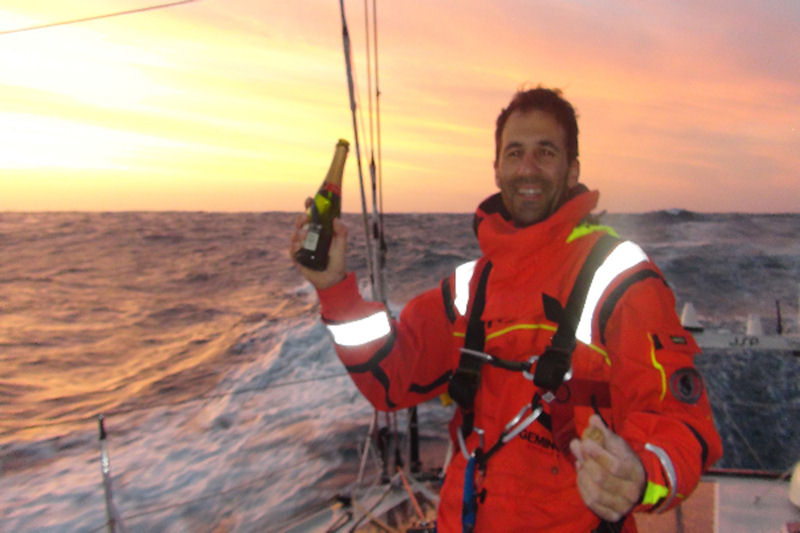
Champagne for Alessandro Di Benedetto as he celebrated his passage of the Cape of Good Hope during the Vendée Globe 2012-2013 - photo © Alessandro di Benedetto / Team Plastique
Week 6
In the cold weather conditions, the entire Vendée Globe fleet was then sailing in the Southern Ocean. Seeing the pace at the forefront, it was difficult to imagine the leading men were in any kind of discomfort. Yet they kept their pace up, trapped in a duel where the tiniest slowdown was immediately punished. Gabart was the first to make his entry into the Pacific Ocean. Maximizing their weather systems, with a slightly higher speed and perfect navigation, the two leaders continued to increase their lead.
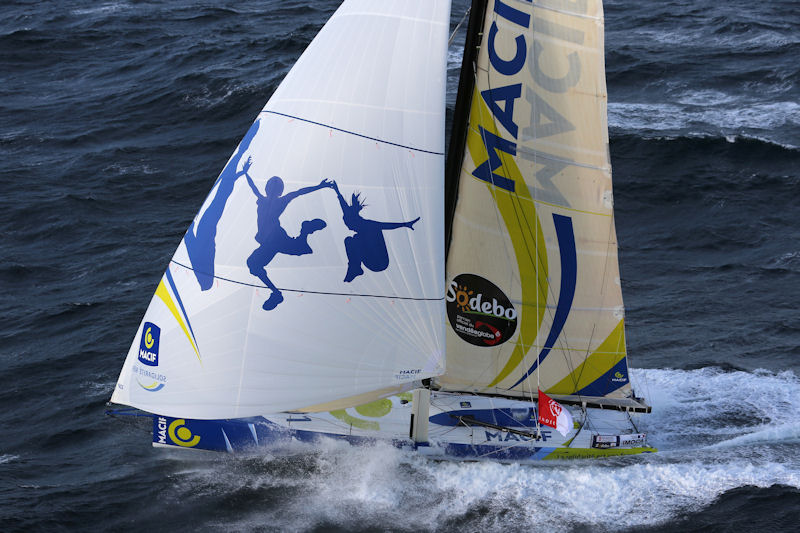
Francois Gabart on MACIF takes the lead again over Armel Le Cléac'h on Banque Populaire during the Vendée Globe 2012-2013 - photo © Jean Marie Liot / DPPI / Vendee Globe
Week 7
As Christmas was approaching, the pace didn't falter and the two leaders continued their global duel under New Zealand. As he entered the Pacific Ocean, Le Cléac'h managed to take over the lead before seeing Gabart regained control before the rankings changed with each of the skippers' jibes. A little more than 500 miles behind, Dick became a bit stalled and stayed between the head of the fleet and the Anglo-Swiss duo Thomson-Stamm, about 900 miles behind the front runners. For Christmas, Le Cléac'h got to the first West Pacific gate first and temporarily took over the lead. For Stamm, Christmas was much tougher since he had to divert to New Zealand in order to find a shelter and make some repair on his hydrogenerators. He was almost out of energy and couldn't consider crossing the Pacific, the largest ocean in the world, in these conditions. The deterioration of the weather conditions forced him to moor to a Russian ship, which resulted in a complaint procedure against the sailor, who had received assistance in the operation. When the Swiss skipper resumed his journey towards Cape Horn, he was in 10th position, just behind Arnaud Boissières who, after a difficult start, had managed to come back in the Southern ocean. Meanwhile, the two leaders were slowed down and saw Dick and Thomson come back in their wake. On December 28th, only Di Benedetto had not yet entered the Pacific, sailing about 4,000 miles away from the head of the fleet.
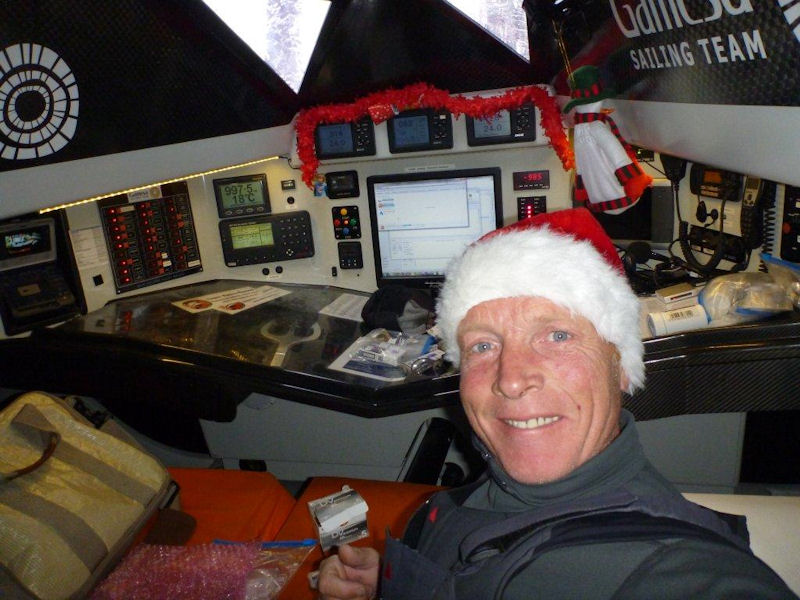
Christmas at sea for Mike Golding in the Vendée Globe 2012-2013 - photo © Mike Golding / Gamesa
Week 8
Even when the leaders were somehow slowed down while approaching Cape Horn, their nearest competitor, Jean-Pierre Dick, remained 400 miles away when they rounded the legendary rock on January 1st, 2013. Gabart rounded it first and was only 1:15h ahead of Le Cléac'h. But skippers would have to wait some more for some relief as the way down towards the extreme south of the Chilean archipelago was made under the threat of icebergs believed to have drifted all the way up to Staten Island. At the same time, Di Benedetto entered the Pacific Ocean. A little less than two days later, Dick rounded the last cape of the race, 250 miles before Thomson. We then had to wait for six and a half days to see Le Cam coming back into the Atlantic. He opened the way to a squad that had grown in the Southern Seas. Stamm, Boissières and Sanso had joined the "senior sailors" crew and the newly-formed group was then sailing within 500 miles of each other. The skipper of Cheminées Poujoulat, victim of another crash that had badly damaged his hydrogenerators, while the other one was no longer working, was forced to make diesel refuel after Cape Horn. It meant he was out of the race just before the jury confirmed his disqualification.
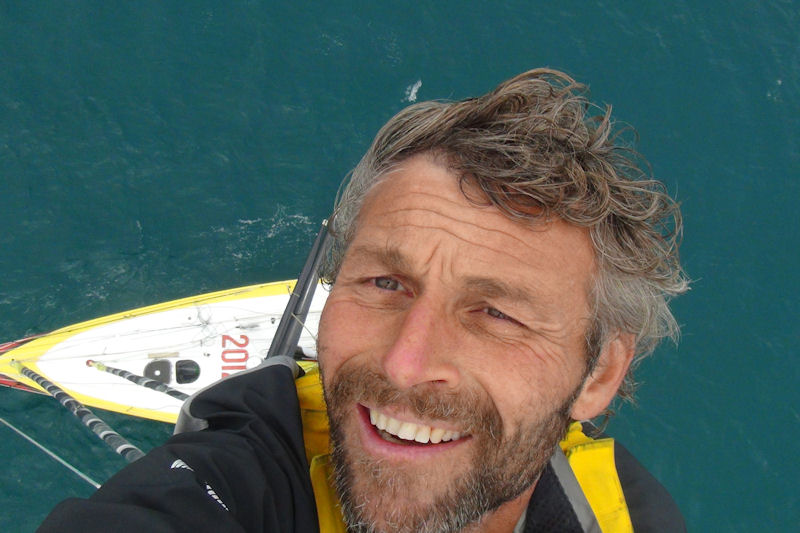
Bernard Stamm on Cheminées Poujouat at anchor in Dunedin during the Vendée Globe 2012-2013 - photo © Bernard Stamm / Cheminées Poujouat
Week 9 – Week 11
Even if Cape Horn was now behind them, the route was still long and if the leaders had then left the Southern Seas, they quickly faced winds of 45 knots and 6-metre swell. For the leading trio, the way up the Atlantic began abruptly and cruelly for Dick, who – after a great comeback on the leading duo – had to slow down in order to repair his main stay. For Le Cléac'h, the problems were less dramatic but equally disastrous in terms of consequences. A problem with his gennaker in the Le Maire Strait made him lose ground again when he managed to return on Gabart, only 10 miles behind him. On January 6th, a shift in the west he thought beneficial became a real nightmare, as the crossing became more complicated than expected. 100 miles away, on January 8th, the gap extended over 260 miles six days later. This would be the largest gap in the race. Through less easy doldrums crossing for the young leader, Le Cléac'h managed to come back a little, but it wasn't enough.
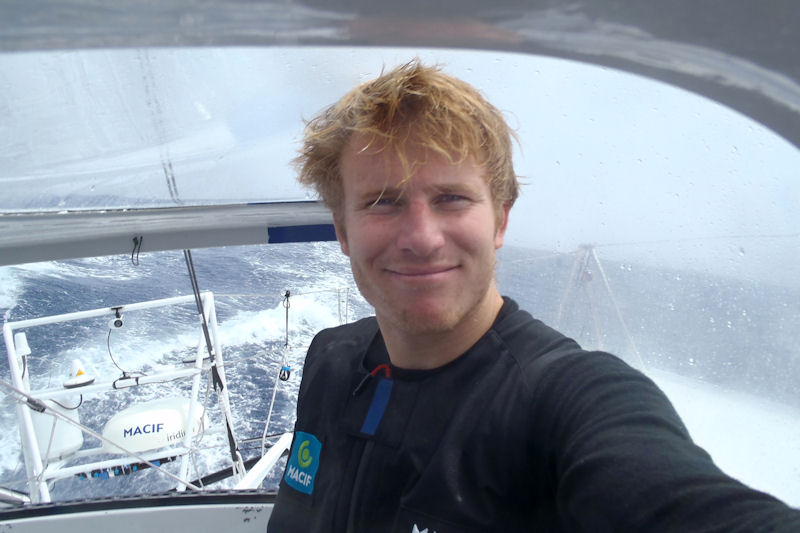
Francois Gabart on MACIF leads the Vendée Globe 2012-2013 up the South Atlantic Ocean - photo © Francois Gabart / Macif
Finish
On January 27th, 2013, at 15h18 (French Time), François Gabart crossed the finish line and entered the Sables d'Olonne channel as a hero, after an incredible duel that lasted 78d02h16' or 28,646 miles travelled at an amazing average speed of 15.3 knots. Only 3:17h later, Armel Le Cléac'h completed his world circumnavigation, just in time to enter the channel, still warmed by the enthusiasm of a great public. It was definitely a historic day, which saw the finishes of two exceptionally gifted young sailors, the first to single-handedly sail around the world on a monohull in less than 80 days.
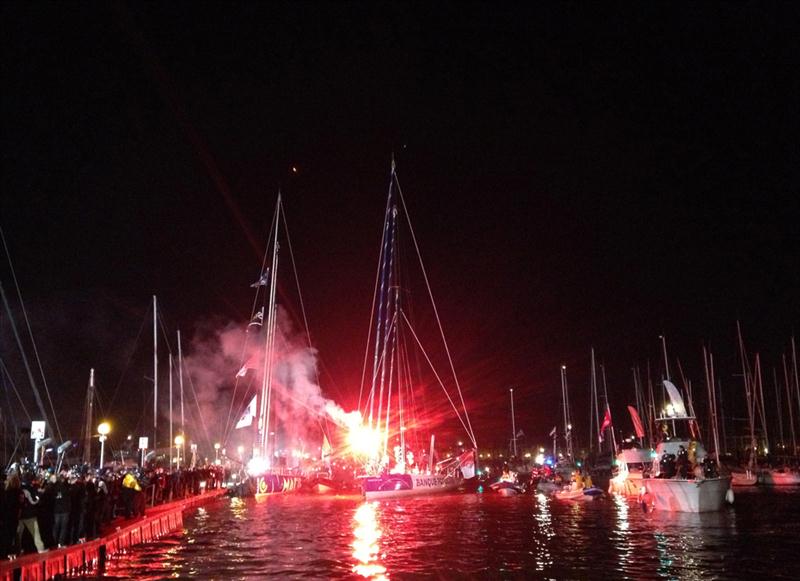
Francois Gabart on MACIF wins the Vendee Globe 2012-2013 - photo © Christophe Launay /
www.sealaunay.com
Two days later, Alex Thomson takes the third place of the podium thanks to an amazing performance on a second-generation boat built in 2007. The British was indeed helped by Dick's technical issues, as the Virbac Paprec skipper finished 4th after sailing 2,650 miles without the keel he had lost 600 miles south of the Azores archipelago.
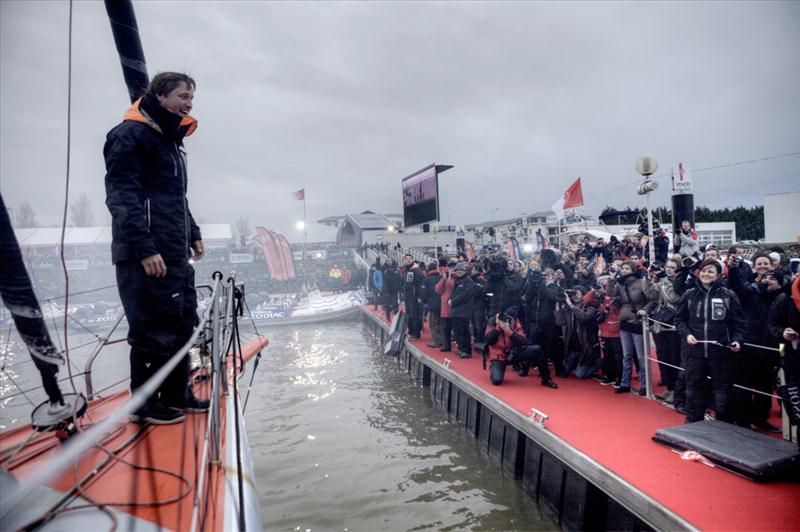
Alex Thomson finishes third in the Vendee Globe 2012-2013 - photo © Christophe Launay /
www.sealaunay.com
The Atlantic proved to be very rough to the "senior sailors" and the first of them, Jean Le Cam, did not enter the Sables d'Olonne channel before February 6, followed by Mike Golding and Dominique Wavre.
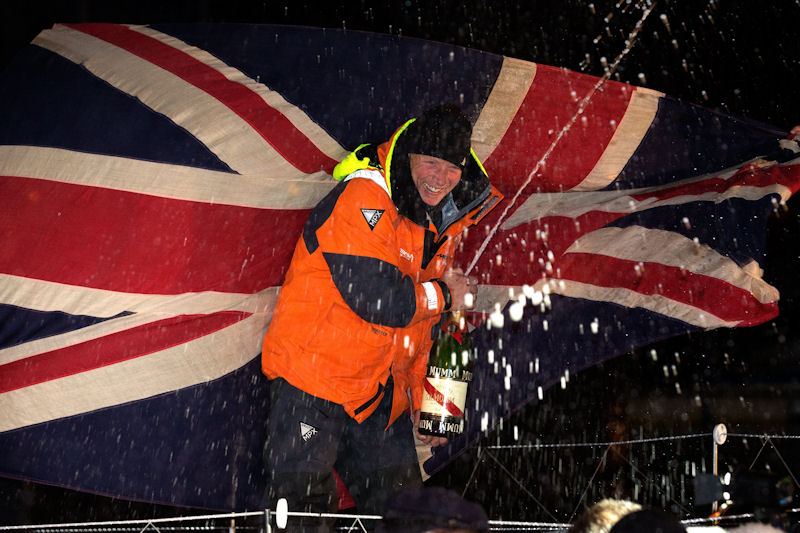
Mike Golding on Gamesa finishes the Vendée Globe 2012-2013 - photo © Jean Marie Liot / DPPI
Then came Arnaud Boissières and Bertrand De Broc as well as, a little later, Tanguy de Lamotte (Initiatives-cœur). The last skipper to finish the race was Alessandro Di Benedetto, 11th but still celebrated as if he had won the race. Even though he was in 9th position when he crossed the Equator, Javier Sanso was not that lucky. On February 3, he lost his keel 400 miles south of the Azores, which capsised his boat. The Spaniard was eventually rescued by the Portuguese navy.
Vendée Globe 2012-2013 final leaderboard:
1- François Gabart (FRA/MACIF) 78d 02h 18'
2- Armel Le Cléac´h (FRA/Banque Populaire) 78d 05h 33' (+3h17')
3- Alex Thomson (GBR/Hugo Boss) 80d 19h 23' (+2d 13h 49')
4- Jean-Pierre Dick (FRA/Virbac-Paprec 3) 86d 03h 03' (+8d 00h 47')
5- Jean Le Cam (FRA/SynerCiel) 88d 00h 12' (+9d 21h 56')
6- Mike Golding (GBR/Gamesa) 88d 06h 36' (+10d 04h 19')
7- Dominique Wavre (SUI/Mirabaud) 90j 03h 14' (+12d 00h 58')
8- Arnaud Boissières (FRA/AKENA Vérandas) 91d 02h 09' (+12d 23h 52')
9- Bertrand de Broc (FRA/Votre Nom autour du Monde avec EDM Projets) 92d 17h 10' (+14d 14h 53')
10- Tanguy de Lamotte (FRA/Initiatives-coeur) 98d 21h 56' (+20d 19h 39')
11- Alessandro Di Benedetto (FRA-ITA/Team Plastique) 104d 02h 34' (+26d 00h 17')
Not ranked
Bernard Stamm (SUI/Cheminées Poujoulat), disqualified
Did not finish
Marc Guillemot (FRA/Safran): Lost keel on November 10
Kito de Pavant (FRA/Groupe Bel): Hit a fishing boat on November 12
Louis Burton (FRA/Bureau Vallée): Hit a fishing boat on November 14
Sam Davies (GBR/Savéol): Dismasted on November 15
Jérémie Beyou (FRA/Maître CoQ): Broken keel jack issue on November 17
Zbigniew Gutkowski (POL/ENERGA): Autopilot issue on November 21
Vincent Riou (FRA/PRB): Hit an UFO on November 24
Javier Sanso (ESP/ACCIONA 100% EcoPowered): Capsised on February 3
www.vendeeglobe.org/en/